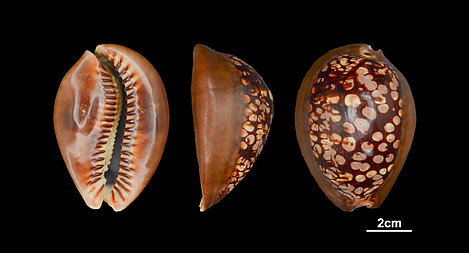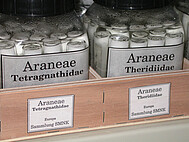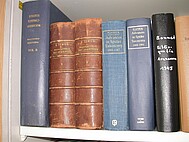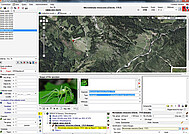Mollusca
The collection had its origin in 14 drawers containing at least 714 specimens representing 134 “species” (Mayer 1978), predominantly marine molluscs collected by the Hereditary Prince Friedrich, son of the founder of Karlsruhe (Mayer 1978). It was further enlarged by Karoline Luise. However, soon after her death, the director of the cabinet of natural history K. C. Gmelin complained about the neglected condition of the collection (May 1906). He documented the inventory of Conchylia in a (still existing) catalogue of 384 pages, entitled Testacea Musei Principio Badensis, in the years 1786-1787 (Fig. 6). Unfortunately, in this catalogue individual specimens are not listed with collection numbers, but only with numbers referring to species in the corresponding volumes of the 12th edition of Linné’s Systema Naturae. Presumably, shells from this and also from the Conchylia collection of the Meersburger Episcopalian cabinet of naturalia, acquired in 1803, still exist, but are not readily discernable within the current large mollusk shell collection (< 20,000 specimens; see below).
Still under the direction of Gmelin, the mollusk collection grew strongly. Between 1830 and 1836, Wilhelm Schimper purchased shells from southern France and oberst G.J. Peitsch donated 1243 shells of 600 exotic species, among them many rare and precious pieces of volutes, cowrie and cone shells (May 1906).
Later, director Alexander Braun (1837-1845) sought to complete the collection, adding genera to date not included by purchases and donations, and not least by selling his own rich collection of terrestrial and fresh water mollusks to the cabinet (May 1906). This ambition was followed by his successor Moritz August Seubert (1846-1873), who itself donated conchylia from Java and bought several species from Landauer (Frankfurt/Main) in 1866 and 1868 (May 1906). The last large additions came from donations of Carl Kreglinger in 1881 (> 4,000 specimens) and Adolf Schütt in 1889 (nearly 2,000 specimens) under the direction of Adolph Knop (Angst 1985).
Between 1907 and 1911, Max Auerbach created a registry of entrances for the Conchylia in two volumes, containing 9,091 entries, and notes on the collections of Kreglinger and Schütt. In this catalogue the zoological curator Joseph Hauer noted in 1955, that most of the mollusk shells had been rescued from the fire in 1942, but got into disorder during the following rush. Only a part of the collection (from Kreglinger) was reordered, other parts (formerly registered as “Alte Sammlung”, “Nat.-Cabinett” and “Sammlung Schütt”) were merged as “Allgemeine Sammlung” without changing the systematic order or identifying specimens. Starting in 1959, the zoological curator Helmut Knipper (1914-1974) rearranged the whole collection based on a new taxonomic system in about 20 large cabinets. He also increased the collection by sampling land and fresh water mollusks in Europe and East Africa. Although there were some attempts to enlarge and register parts of the collection, a transfer from the main building to an external depot and to other cabinets did not improve matters, and until today the collection has more or less remained in this condition and order, making it extremely difficult to recognize historically important specimens or to mobilize data on the collection by a digital compilation.

Curator in charge

Dr. Hubert Höfer, Dipl.-Biol.
Phone: +49 721 175 2826
E-Mail: hubert.hoefer[at]smnk.de









